
The Solar-Terrestrial Centre of Excellence (STCE) is a collaborative network of the Belgian Institute for Space Aeronomy, the Royal Observatory of Belgium and the Royal Meteorological Institute of Belgium.
 |
Published by the STCE - this issue : 6 Mar 2014. The Solar-Terrestrial Centre of Excellence (STCE) is a collaborative network of the Belgian Institute for Space Aeronomy, the Royal Observatory of Belgium and the Royal Meteorological Institute of Belgium. |
| Archive of the newsletters | Subscribe to this newsletter by mail |
Everybody has noticed it: Over the last few months, solar activity has shifted into a higher gear.
Since October last year, more and bigger sunspot groups have appeared on the solar disk, gradually driving the monthly sunspot number to new heights. Indeed, in February, preliminary values (SILSO at http://www.sidc.be/silso/) for the international sunspot number reached 102.8, the highest so far this solar cycle. Also the smoothed sunspot number is on the rise and easily surpasses the previous "maximum" that occurred late 2011-early 2012. Five years after its start in December 2008, Solar Cycle 24 (SC24) seems finally to have arrived at its maximum.
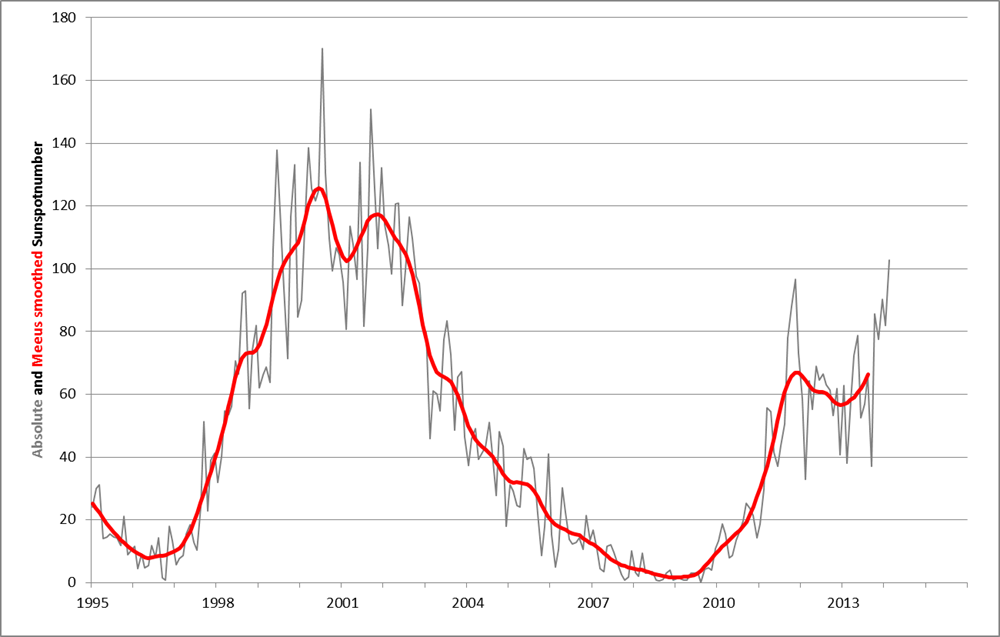
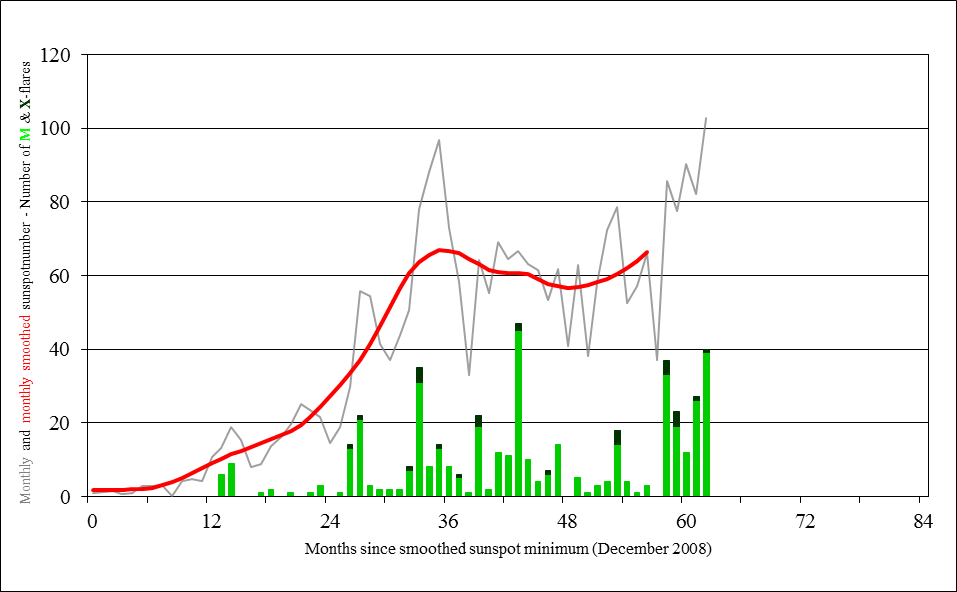
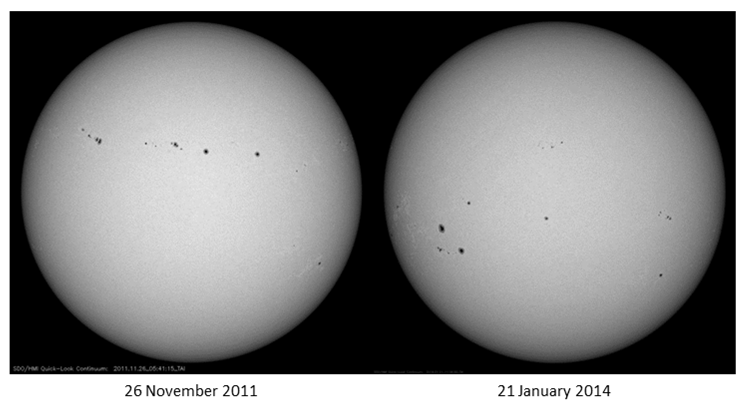
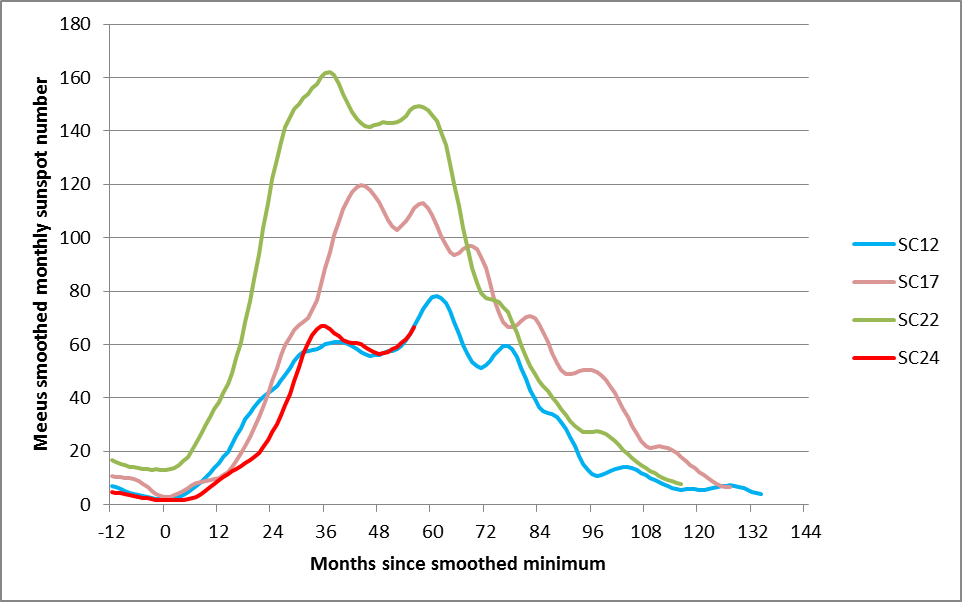
The highlight of the week was the X4.9 flare peaking at 00:49UT on 25 February. It took place in NOAA 1990 while it was still close to the solar east limb. This was a recurrent active region (AR), previously known as AR NOAA 1967 and AR NOAA 1944.
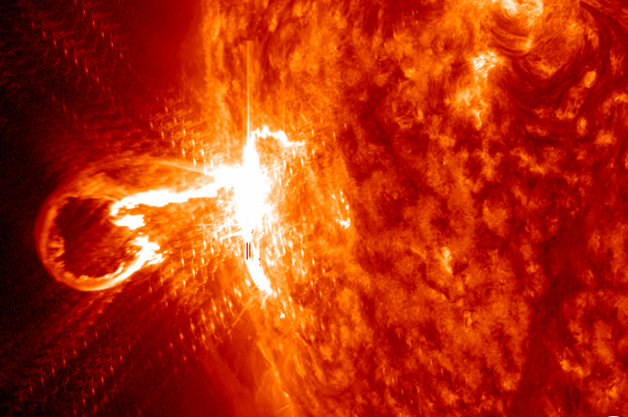
The flare was associated with a gradual solar proton event that crossed the event threshold (for particles having energies greater than 10 MeV) around 14:00UT on the same day. This moderate proton event remained above the threshold until early 3 March.
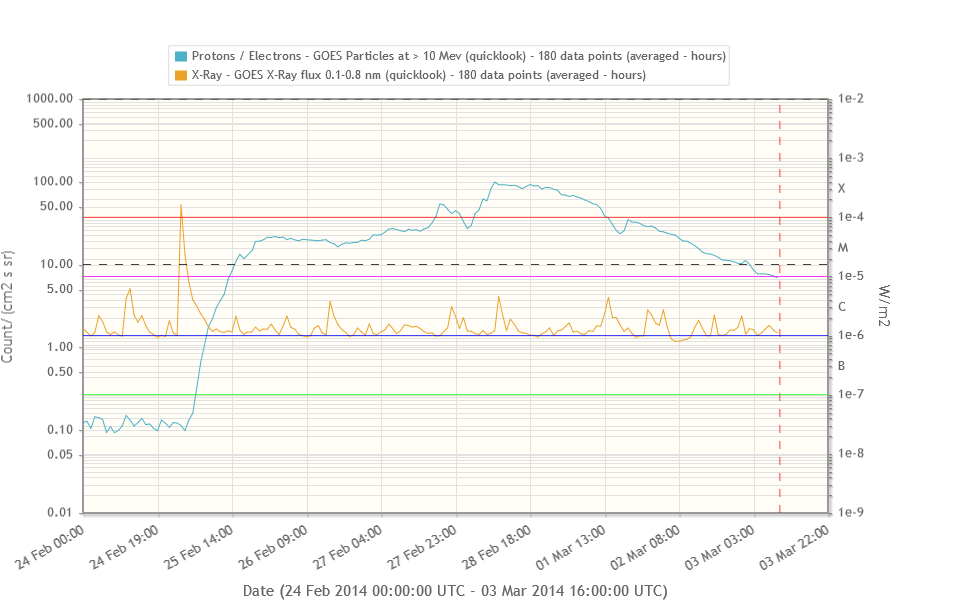
The X4.9 flare was also associated with a CME that expanded to a full halo CME with propagation speeds above 1500 km/s. Radio bursts were observed by the e-Callisto receivers in Malaysia and Alaska. Culgoora Observatory observed type II radio bursts with speeds of 2000 km/s and 700 km/s.
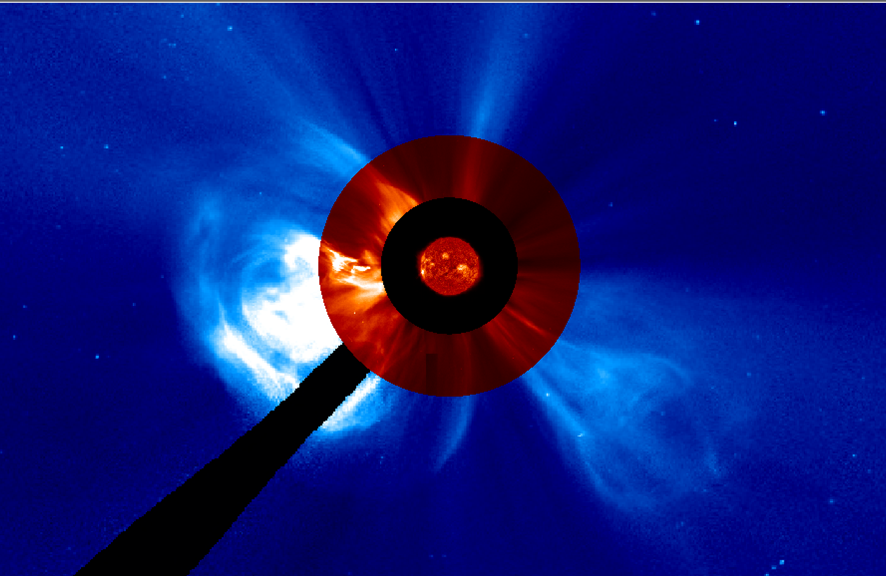
| DAY | BEGIN | MAX | END | LOC | XRAY | OP | 10CM | TYPE | Cat | NOAA |
| 24 | 1103 | 1117 | 1142 | M1.2 | F | 1990 | ||||
| 24 | 1200 | 1205 | 1210 | M1.3 | II/2 | 1990 | ||||
| 25 | 0039 | 0049 | 0103 | X4.9 | B | 3700 | II/1V/2I/3 | 52 | 1990 | |
| 26 | 1452 | 1501 | 1510 | S13W44 | M1.1 | 1N | III/2 | 46 | 1982 | |
| 28 | 0044 | 0048 | 0050 | S24E53 | M1.1 | SN | 59 | 1991 | ||
| 01 | 1318 | 1333 | 1340 | M1.1 | 46 | 1982 | ||||
| 02 | 2311 | 2319 | 2326 | N15W74 | M1.1 | SF | 1986 |
| LOC: approximate heliographic location | TYPE: radio burst type |
| XRAY: X-ray flare class | Cat: Catania sunspot group number |
| OP: optical flare class | NOAA: NOAA active region number |
| 10CM: peak 10 cm radio flux |
Solar flare activity fluctuated between low and moderate during the week.
In order to view the activity of this week in more detail, we suggest to go to the following website from which all the daily (normal and difference) movies can be accessed: http://proba2.oma.be/ssa
This page also lists the recorded flaring events.
A weekly overview movie can be found here (SWAP week 205).
http://proba2.oma.be/swap/data/mpg/movies/WeeklyReportMovies/WR205_Feb24_Mar02/weekly_movie_2014_02_24.mp4
Because of a science campaign with proba2 a part of the weekly movie doesn't have the Sun centered.
Details about some of this week's events, can be found further below.
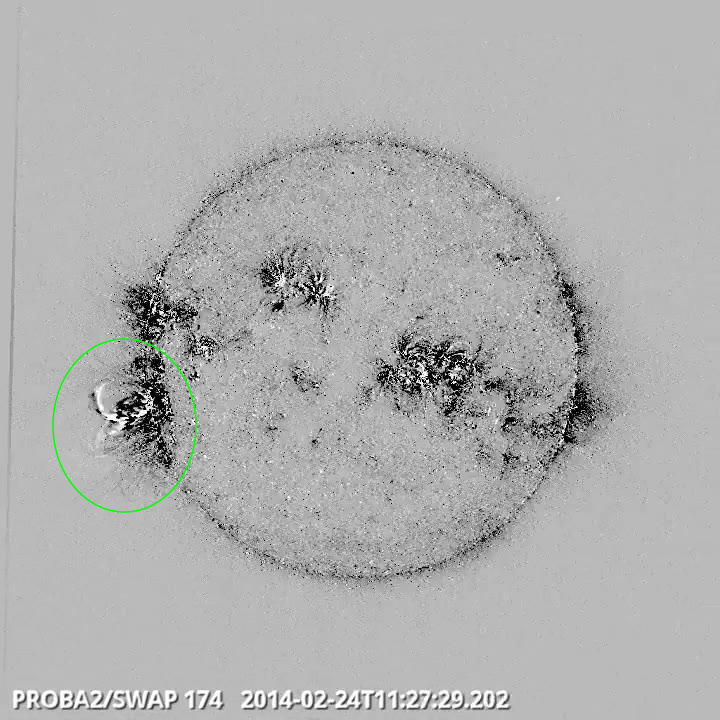
Failed eruption on the east limb @ 11:27 SWAP difference image
Find a movie of the events here (SWAP difference movie)
http://proba2.oma.be/swap/data/mpg/movies/WeeklyReportMovies/WR205_Feb24_Mar02/Events/20140224_FailedEruption_EastLimb_1127_swap_diff.mp4
Find a movie of the events here (SWAP movie)
http://proba2.oma.be/swap/data/mpg/movies/WeeklyReportMovies/WR205_Feb24_Mar02/Events/20140224_FailedEruption_EastLimb_1127_swap_movie.mp4
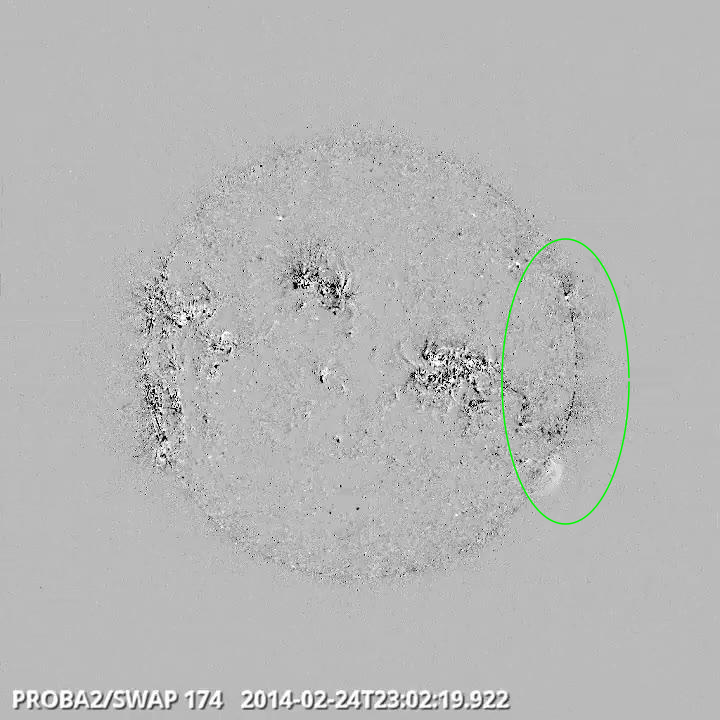
Eruptions on the west limb @ 23:02 SWAP difference image
Find a movie of the events here (SWAP difference movie)
http://proba2.oma.be/swap/data/mpg/movies/WeeklyReportMovies/WR205_Feb24_Mar02/Events/20140224_Eruptions_WestLimb_2302_swap_diff.mp4
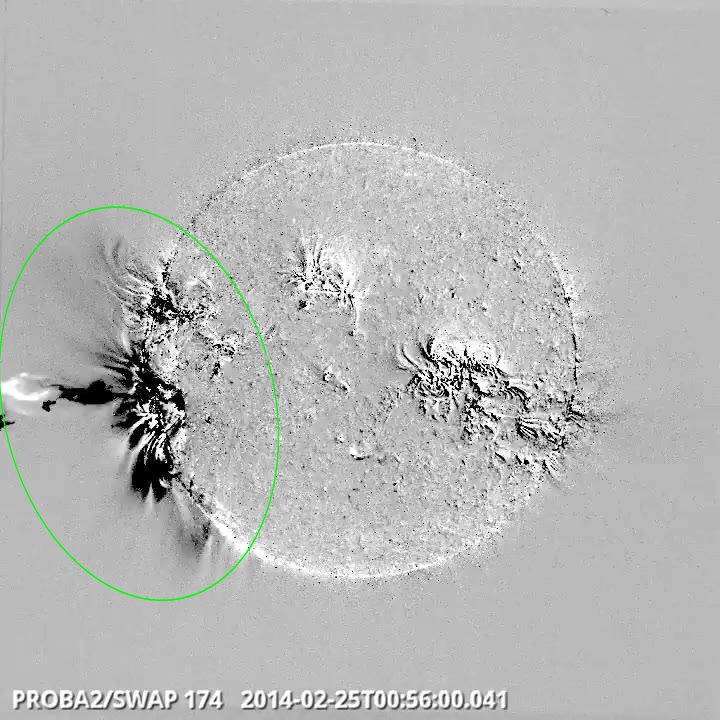
Eruptions and X flare on the west limb @ 00:56 SWAP difference image
Find a movie of the events here (SWAP difference movie)
http://proba2.oma.be/swap/data/mpg/movies/WeeklyReportMovies/WR205_Feb24_Mar02/Events/20140225_Eruption_EastLimb_0056_swap_diff.mp4
Find a movie of the events here (SWAP movie)
http://proba2.oma.be/swap/data/mpg/movies/WeeklyReportMovies/WR205_Feb24_Mar02/Events/20140225_Eruption_EastLimb_0056_swap_movie.mp4
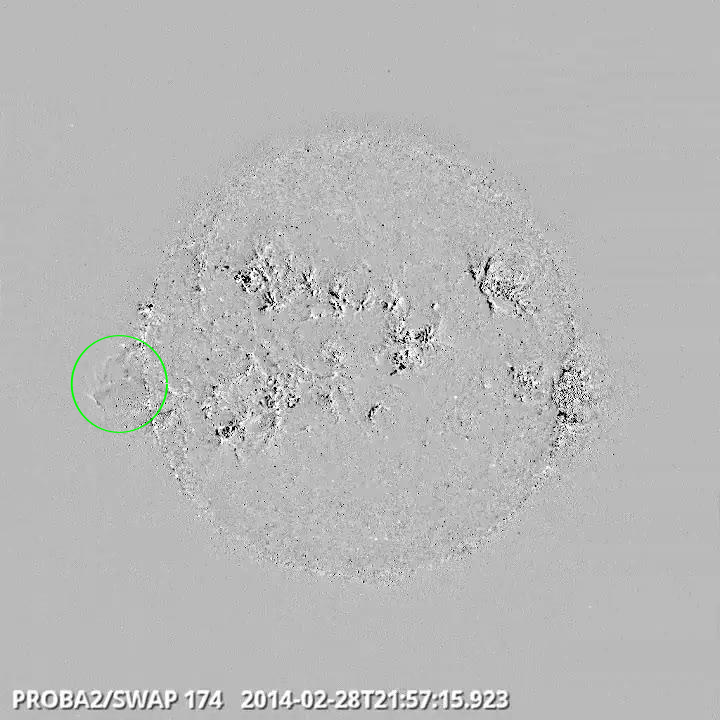
Slow eruptions on the east limb @ 21:57 SWAP difference image
Find a movie of the events here (SWAP difference movie)
http://proba2.oma.be/swap/data/mpg/movies/WeeklyReportMovies/WR205_Feb24_Mar02/Events/20140228_SlowEruption_EastLimb_2157_swap_diff.mp4
Find a movie of the events here (SWAP movie)
http://proba2.oma.be/swap/data/mpg/movies/WeeklyReportMovies/WR205_Feb24_Mar02/Events/20140228_SlowEruption_EastLimb_2157_swap_movie.mp4
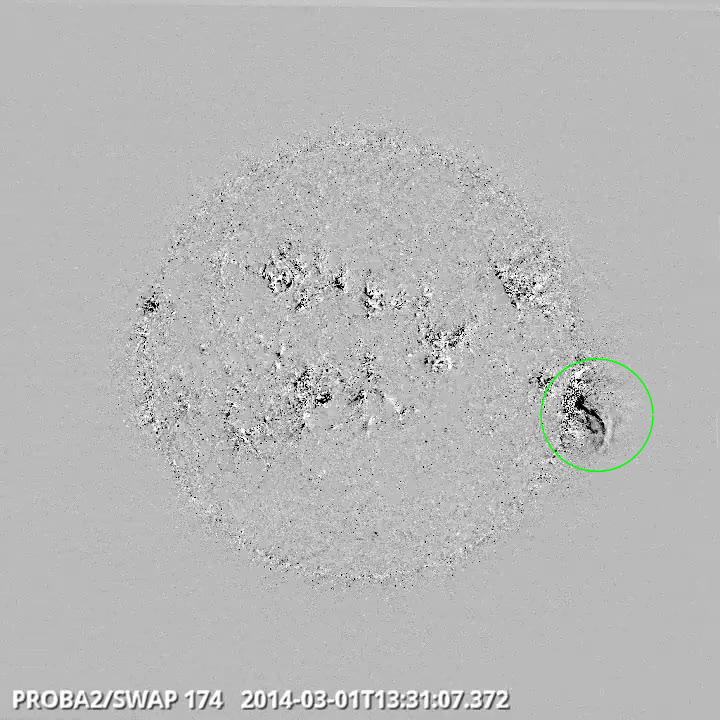
Eruptions on the west limb @ 11:31 SWAP difference image
Find a movie of the events here (SWAP difference movie)
http://proba2.oma.be/swap/data/mpg/movies/WeeklyReportMovies/WR205_Feb24_Mar02/Events/20140301_Eruption_WestLimb_1331_swap_diff.mp4
This paper discusses an event study of a streamer observed on 2010 October 20 and 21, by several instruments including PROBA2/SWAP EUV telescope.
Goryaev, F.; Slemzin, V.; Vainshtein, L.; Williams, David R. 2014 "Study of Extremeultraviolet
Emission and Properties of a Coronal Streamer from PROBA2/SWAP, Hinode/EIS and Mauna
Loa Mk4 Observations"
http://adsabs.harvard.edu/abs/2014ApJ...781..100G
A "glancing blow" shock of the CME associated with the X4.9 flare of 25 February was observed by the ACE spacecraft on 27 February after 16:00UT, which was much later than what was anticipated by ENLIL modelling (27 February at 00:00UT). Solar wind speed jumped from 350 km/s to just over 500 km/s.
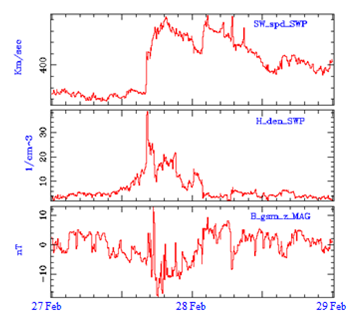
This lead to a geomagnetic storm at the K=5 level in Dourbes and Kp=6 (NOAA, estimated). Remarkably, northern lights were observed as south as Scotland and the north of The Netherlands and Germany (night from 27-28 February). A movie from the event, made by an all-sky camera near the Belgian coast, can be found at http://youtu.be/_cw-tys0Ax8 (credits Astrolab Iris, Franky Dubois). Note that, at these locations, the polar lights were only just above the horizon which made them harder to see by the naked eye than to make a picture of it.
Besides this episode, geomagnetic activity was quiet during the week.
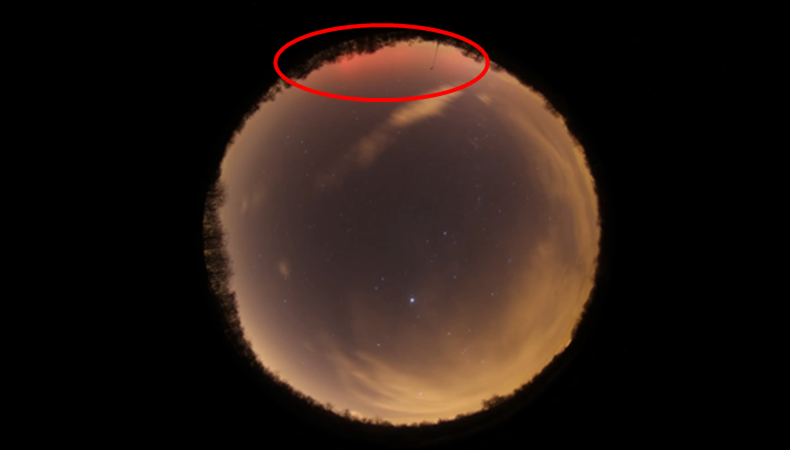
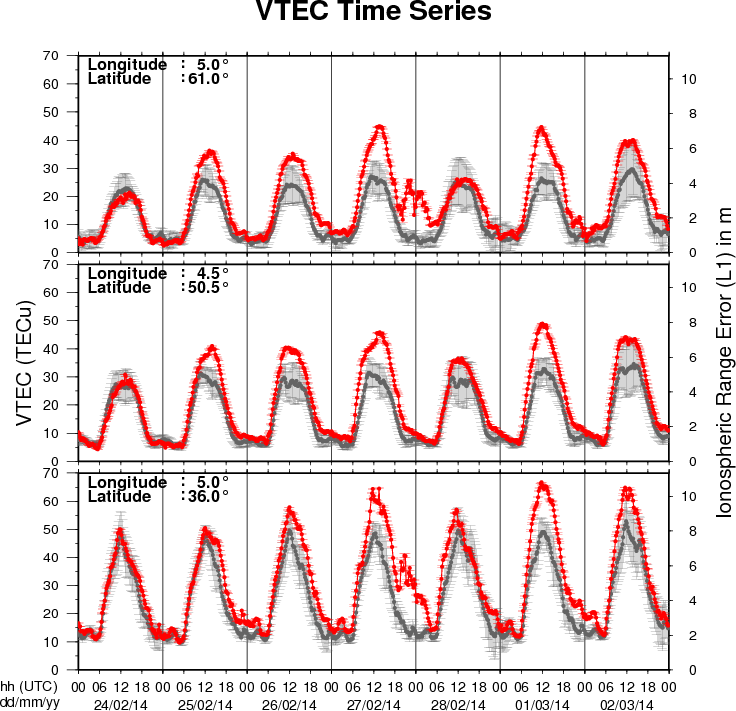
The figure shows the time evolution of the Vertical Total Electron Content (VTEC) (in red) during the last week at three locations:
a) in the northern part of Europe(N61°, 5°E)
b) above Brussels(N50.5°, 4.5°E)
c) in the southern part of Europe(N36°, 5°E)
This figure also shows (in grey) the normal ionospheric behaviour expected based on the median VTEC from the 15 previous days.
The VTEC is expressed in TECu (with TECu=10^16 electrons per square meter) and is directly related to the signal propagation delay due to the ionosphere (in figure: delay on GPS L1 frequency).
The Sun's radiation ionizes the Earth's upper atmosphere, the ionosphere, located from about 60km to 1000km above the Earth's surface.The ionization process in the ionosphere produces ions and free electrons. These electrons perturb the propagation of the GNSS (Global Navigation Satellite System) signals by inducing a so-called ionospheric delay.
See http://stce.be/newsletter/GNSS_final.pdf for some more explanations ; for detailed information, see http://gnss.be/ionosphere_tutorial.php
Lecture given to the members and public audience at the Cosmodrome Public Observatory. It focuses mainly on the effects of space weather, extreme space weather, and the space weather forecast team at the Space Pole (RWC Brussels).
In Dutch, 30 attendees
http://www.spaceweather.eu/en/repository/show?id=487
Lecture focusing on the effects of space weather, extreme space weather, and the space weather forecasting at the Space Pole (RWC Brussels).
The lecture was given to the astronomical association GALILEO in Heerlen, Nederlands-Limburg, The Netherlands.
Solar amateur astronomers and public audience, in Dutch, about 20 attendees.
http://www.spaceweather.eu/en/repository/show?id=488
http://www.spaceweather.eu/en/repository/show?id=489
Presentation supporting the splinter meeting, see http://www.stce.be/esww10/splinters/ssa.php
http://www.spaceweather.eu/en/repository/show?id=490
Start : 2014-03-30 - End : 2014-04-04
Biennial CCMC community workshops are designed as opportunities
for an in-depth exchange of experiences, opinions and needs between
model owners, science and operational users, agency representatives
and the CCMC staff.
Website:
http://ccmc.gsfc.nasa.gov/CCMC_Workshop_2014/index.php
Start : 2014-04-27 - End : 2014-05-02
The EGU General Assembly 2014 will bring together geoscientists
from all over the world to one meeting covering all disciplines of
the Earth, planetary and space sciences. The EGU aims to provide a
forum where scientists, especially early career researchers, can
present their work and discuss their ideas with experts in all
fields of geosciences.